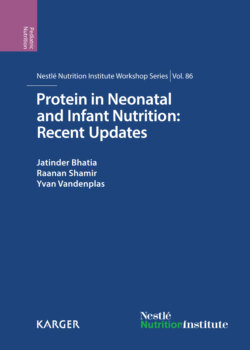Читать книгу Protein in Neonatal and Infant Nutrition: Recent Updates - Группа авторов - Страница 32
На сайте Литреса книга снята с продажи.
Partially versus Extensively Hydrolyzed Formulas
ОглавлениеOnly few studies compared the effect of pHFs and eHFs [29, 31]. Differences in the study design, definition of atopic manifestations, selection of formulas (not all commercially available), presence of concomitant intervention and small sample sizes limited the comparative analysis [31].
In a prospective comparative Danish study, 595 high-risk infants were randomized at birth to one of three different blinded formulas. Of 478 infants who completed the study, 232 were exclusively breastfed, 79 received eHF-C, 82 eHF-W and 85 pHF-W during the first 4 months of life. The three formula groups were identical in regard to the atopic predisposition, cord blood IgE, birthplace, tobacco smoke exposure, gender, duration of breastfeeding, and age at introduction of the formula and solid foods. No significant differences were found in the three groups regarding the cumulative incidence of atopic dermatitis or respiratory symptoms. pHF was found to be less effective than eHF in preventing CMA (0.6 vs. 4.7%; p = 0.05) [34].
GINI, the largest German study, prospectively analyzed 2,252 at-risk infants, of which 945 represented the intervention arm and were randomly assigned to receive one of three HFs (n = 689) or CM-SF (n = 256). The 3 HFs were pHF-W, eHF-W and eHF-C [35]. The authors reported a significant reduction in eczema at all study points (1, 3, 6 and 10 years) when using the pHF (odds ratio, OR, 0.56; 95% CI 0.32-0.99) or the eHF-C (OR 0.42, 95% CI 0.22-0.79) but not with eHF-W or CM-SF. The RRs for the cumulative incidence of atopic dermatitis in the intention-to-treat analysis (n = 2,252) were 0.82 (95% CI 0.68-1.00) for pHF-W, 0.91 (95% CI 0.76-1.10) for eHF-W and 0.72 (95% CI 0.58-0.88) for eHF-C compared with the infant SF. The cumulative incidence of atopic manifestations was better reduced with the eHF-C compared to the other HFs. No effect was found regarding rhinitis, asthma and urticaria [30, 35]. Thus, this study highlights that different hydrolysates may have different effects on atopic disease [17].
Economic analyses in 5 European countries (Denmark, France, Germany, Spain and Switzerland) have evaluated the costs and cost-effectiveness of a specific brand of 100% pHF-W (NAN-HA®) compared with a CM-SF in the prevention of atopic dermatitis in at-risk children [36, 37]. Outcomes were considered from the perspective of the public health care system (e.g. the Ministry of Health; MOH), family and society. The cost-effective analysis per avoided case of atopic dermatitis showed the following results: pHF-W versus SF EUR 982-1,343 (MOH perspective), EUR -2,202 to -624 (family perspective) indicating savings, and EUR -1,220 to 719 from the societal perspective. The main costs are related to formula (MOH and society) and time loss (family). In the cost-minimization analysis, pHF-W yielded savings of EUR 4.3-120 million compared with eHF-W when the latter was used in disease prevention. In conclusion, pHF-W was cost-effective versus SF in the prevention of atopic dermatitis and cost savings compared with eHF when used in disease prevention [36, 37]. However, it should be noted that Nestlé employees are involved as coauthors in these papers, what may have induced a bias.
